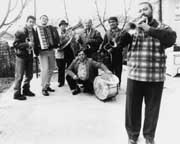 |
|||||||||||||||||||
 |
|||||||||||||||||||
|
Macedonia
|
|||||||||||||||||||
| KOCANI
ORKESTAR The sound of Balkan brass bands was introduced to Western audiences by Emir Kusturica's film Underground. The loudest, flashiest and tightest of these groups, Ko_ani Orkestar comes from the Macedonian city of Ko_ani, located east of the capital Skopje. Its "Romany Oriental Music", in which the stereotypical "oom-pah-pah" marching band sound makes way for incredibly funky Balkan rhythms, might cause culture shock in Czech listeners. It is a potent mix of powerful brass sounds, Turkish-Bulgarian rhythms and Eastern-style solos, at once masterful, brilliant and wild. A certain genius peculiar to Gypsy musicians and the Romany people in general has allowed them to adopt and transform the indigenous musics of the regions they travel through, thereby helping musical styles and songs specific to different cultures and ethnic groups to interconnect and evolve. Destined to their role as professional musicians as a result of their social status, Romanies have, over the ages, often been the sole source and most faithful mirror of the traditional music of the countries they have inhabited. At the same time, thanks to their travels, they have developed an ability to combine a multitude of sources, transforming them into a style that is uniquely their own. Contrary to the preconceived notion that Gypsies have a gift for mimicry, they have always forged music with its own distinctive character, even though they have constantly had to adapt to local demands. For the Romany people, playing music has always been synonymous with creating it. This observation is particularly relevant when it comes to Naat Veliov, trumpet player and leader (kapelnik) of Ko_ani Orkestar. He is considered a master of this particular style, and the brass band he leads has performed his extremely original arrangements all over Macedonia and, lately, the world. The style which brass orchestras from the Balkan region play in is peculiarly "Romany". From western Serbia to Macedonia, these orchestras have demonstrated remarkable ingenuity in transforming the original, static style of traditional brass band music. Such bands were first created in the 19th century, in imitation of the Turkish military bands that began replacing the Mehterhane ensembles of the abolished Janissary order after 1828. It seems that here, as in Turkey, they took the place of the ancient traditional ensembles of oboe (called the zurna, zurla or mizmar) and double-membraned drum. Today these ensembles, which were originally imported from Turkey and made up of Romanies, are dying out, partly because of modernization but also because of growing Macedonian and Serb nationalism. In Ko_ani, a city in the new Republic of Macedonia, Romany brass band music is called Romska Orientalna Musika. Naat Veliov's band is made up of trumpet, cornet, saxophone (alternating with clarinet), 3 baritone horns, tuba, accordion (armonika) and a large drum (tapan) which alternates with the Arabic darabuka. From Albania to Turkey, from Greece to Bulgaria, the Balkans represent a multitude of forms of expression with extremely diverse ethnic origins. Nevertheless, a certain musical legacy of the old Ottoman occupation remains at the heart of this complex rural and pastoral mosaic. The Oriental aspect of Balkan music seems to be have been preserved mainly by the Romanies, who began moving from Turkey in the 14th century, immediately following the Ottoman invasion. The Romanies' own Oriental heritage, their ancient Indian roots, also plays an important role in their musical style. In Macedonia, all of the Romanies are Muslims. They play for the gadje - non-Romanies - as well as for themselves. They have absorbed and incorporated a multitude of styles which they ceaselessly juggle in their music. Their brass bands have kept alive ancient Oriental notions of melody and musical content that evolved from woodwind players' technique of continuous, circular breathing. Slow introductions and improvisations without rhythmic backing are called taksim in Turkish, trepaza in Macedonian. They are considered evocations of a grand meal, where one savors all of the different delicacies in succession. The romantic themes in this music also have several different names and associations. In Turkish they are called gazel, which stems from the Arabic ghazal, a poetic style in which a woman's beauty was compared to the gazelle of the desert. In Macedonian and Serbian the words are sevdak and sevdalinka, respectively, both deriving from sevda, the Turkish word for "passion" or "love". The highly embellished, Eastern-style sevdas have led to a resurgence of Oriental music in the urban context. Styles are constantly being mixed, whether they be Turska (Turkish), Romska (Romany), Burgarska (Bulgarian), Romanska (Romanian) or Srpska (Serbian). Above and beyond regional influences, the Oriental inspiration in the music of the Romanies can also be traced back to their original roots, with melodies imported from Indian cinema often being absorbed into the Romany repertoire. Most of the rhythms are based on those of traditional folk dances. The name _o_ek denotes an Oriental Romany dance for women, while the horo is a collective round dance for men. Here again, the rhythmic patterns have been refined with an appetite for inspiration both ancient and modern, even including the rumba. Going even further in this direction, the leader of Ko_ani Orkestar has succeeded in integrating his own original compositions into the band's traditional repertoire. The group has brought a certain modernity to its sound while avoiding the trap of "jazzifying" this Balkan music, which remains resolutely Oriental thanks to the Romany musicians who play it. Alain Weber |
|||||||||||||||||||
 |
 |
 |
 |
 |
|||||||||||||||
|
|
|||||||||||||||||||